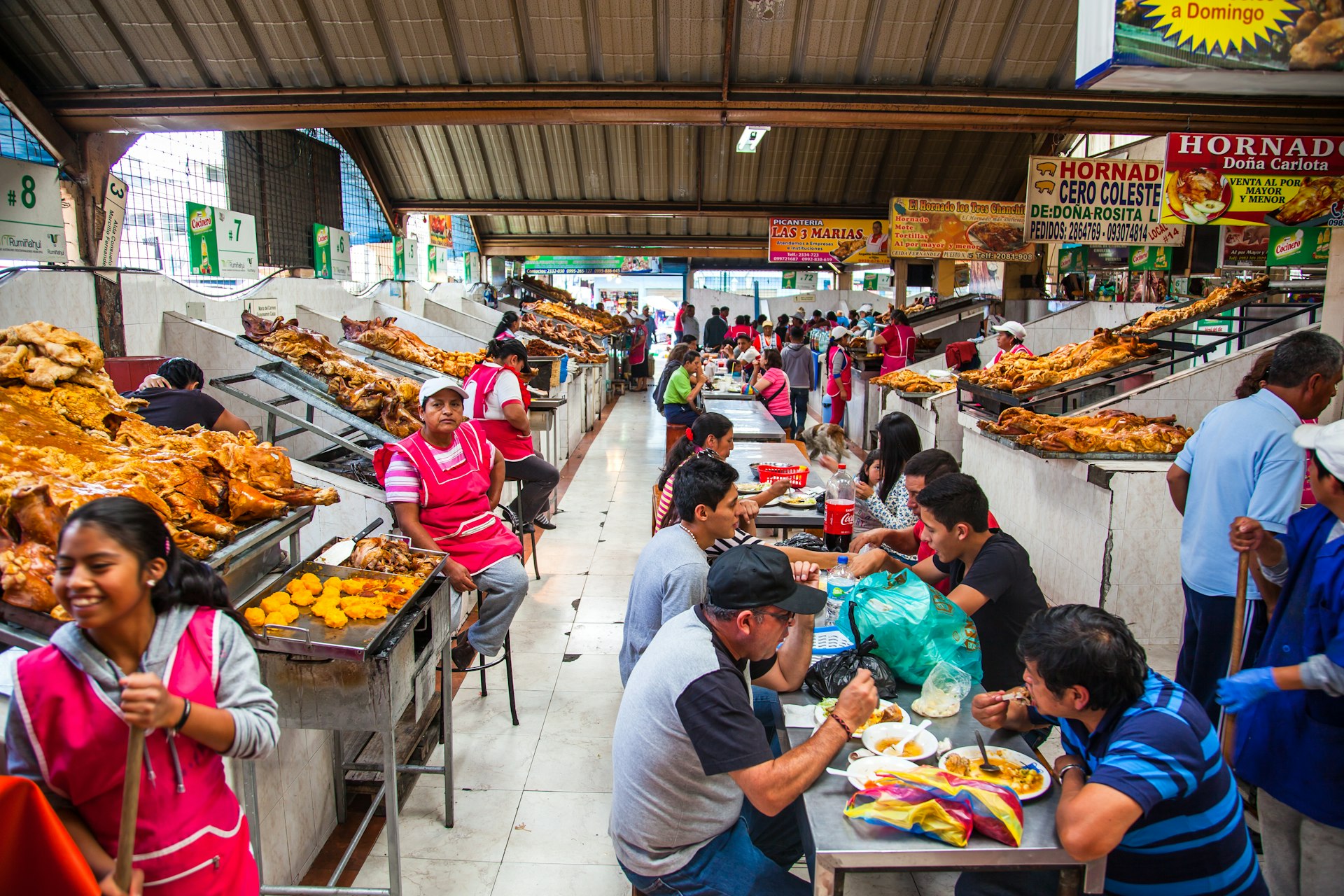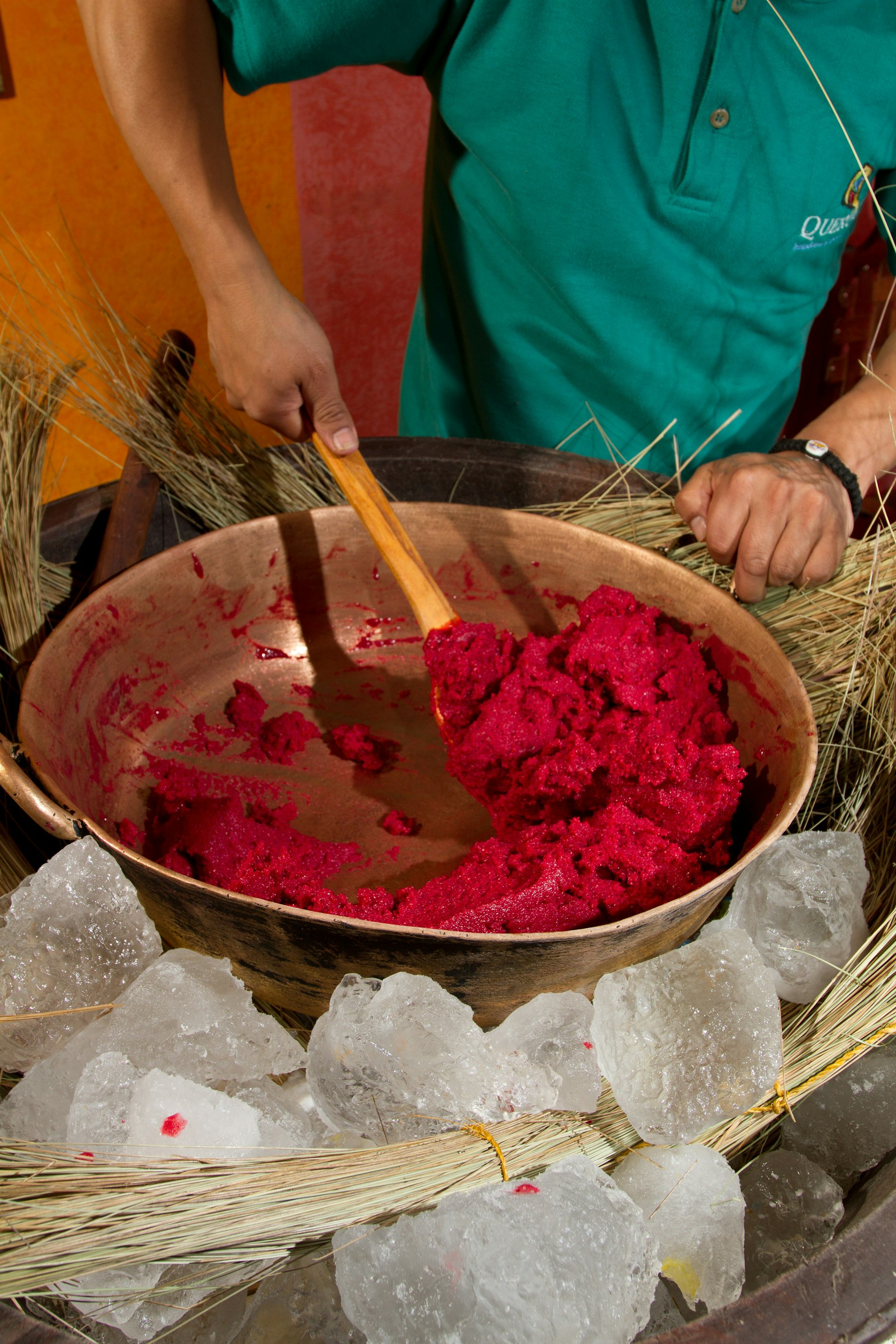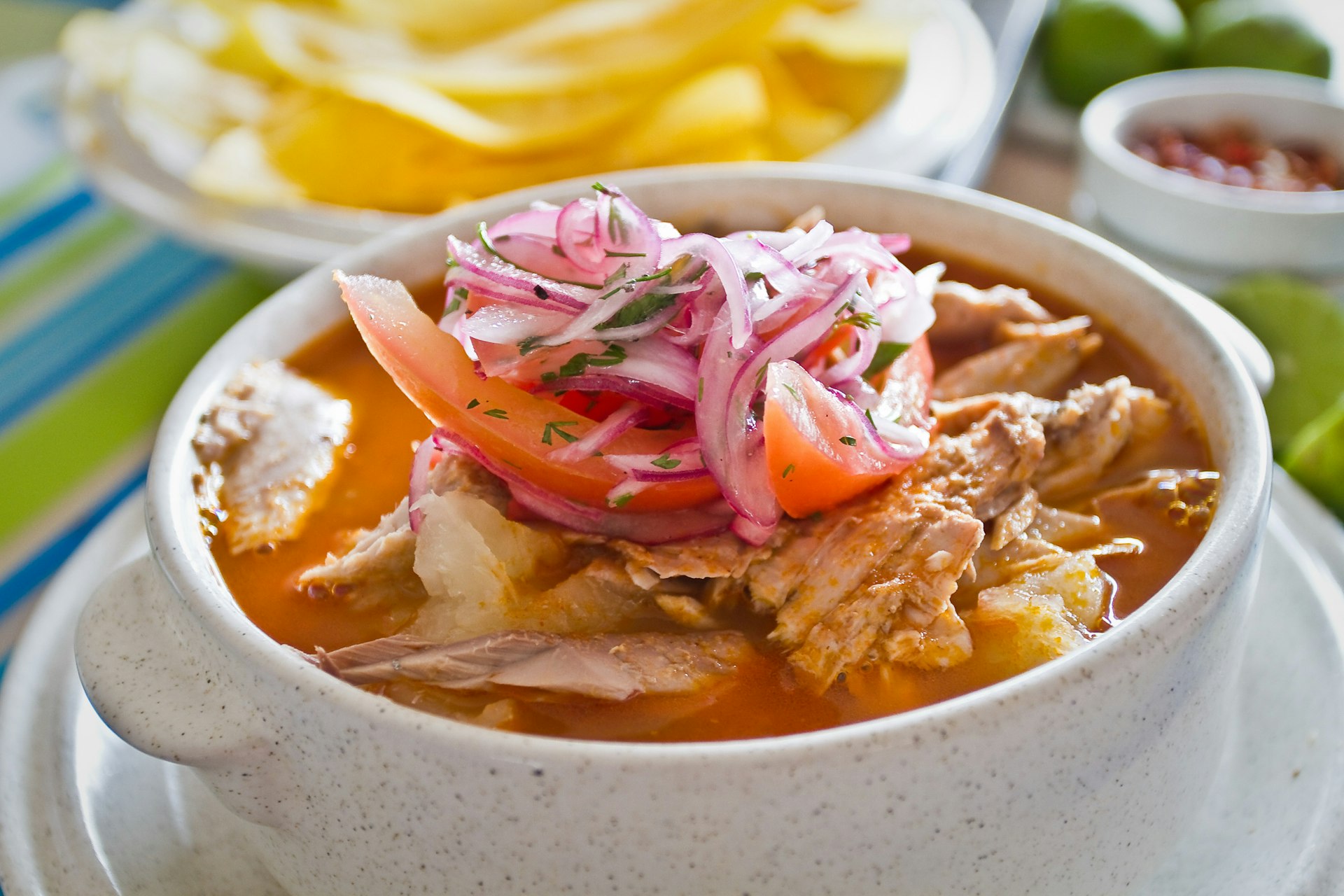With strikingly contrasting geographies packed into just one country, Ecuador’s culinary offerings are as varied and diverse as its four regions. Andean flavors, coastal seafood, Afro-Ecuadorian recipes and Spanish influences converge to create an eclectic and innovative food-and-drink scene.
While heated debates about which region has the best food are commonplace, Ecuadorians’ food-centered culture and strong identity tie all regions together. Ecuadorians pride themselves on their national dishes and are committed to preserving their traditional recipes and introducing them to the global stage.
Here’s our guide to the popular food and drink experiences you should not miss when landing in Ecuador.
Stop by Latacunga for chugchucaras
Rooted in Creole culture and boasting a history spanning over 70 years, chugchucara is one of the most representative dishes from the central highlands. Hailing from the Cotopaxi Province, this savory dish combines a selection of earthy ingredients, including mote (hominy), tostado (toasted corn) and boiled potatoes.
The centerpieces of chugchucara are pork meat and crunchy skin pig pieces fried in large bronze pots (paila de bronce), a once-popular cooking utensil in Ecuadorian kitchens that has now largely been replaced with modern cookware. To balance flavors, this dish, generally plated in large circular trays, also includes maduro (ripe plantain) and empanadas.
Where to try it: While traditional mercados (markets) in Latacunga, Cotopaxi’s capital, will deliver quality takes on this Andean dish, the most popular spot to try it is Chugchucaras La Mamá Negra. Located in central Latacunga, this wood-decorated restaurant is a top recommendation among locals.
Tackle chuchaqui (hangovers) with an encebollado
Considered one of the best soup dishes in the world, encebollado is another national favorite. The savory fish stew is one of the top dishes in Guayaquil, Ecuador’s second-largest city and main port.
Believed to help tackle hangovers, this delicious stew is generally eaten in the mornings — although there’s no wrong time or place to eat an encebollado.
The recipe consists of a yucca (cassava) and albacore base enhanced with pickled onions, coriander and various spices on top.
Where to try it: Deciding where to snag a bowl of encebollado won’t be an easy task — guayacos (people from Guayaquil) will never agree on just one place and their recommendations will widely vary from street stands to hotel restaurants. That said, some of the highest-rated encebollado restaurants in the city include La Casa del Encebollado and El Pez Volador.
Taste some of the best chocolate in the world
In 2018, researchers traced back the earliest evidence of cacao use to at least 5,300 years ago in present-day Ecuador. Thought to have been initially used in ceremonial rituals, cacao has remained an important part of Ecuadorian history through the years.
Throughout the 19th and 20th centuries, the so-called “cacao boom” turned Ecuador into the world’s largest cacao exporter, significantly contributing to the country’s economy before the product drastically fell from grace due to agricultural issues in the 1900s.
But thanks to its high quality, slightly bitter flavor and floral aroma, Ecuadorian cacao has remerged as one of the country’s important exports in recent years. Internationally lauded cacao beans and contemporary chocolate makers have sparked a new wave of chocolate production in Ecuador.
Where to try it: If you’re in Quito, go straight to the award-winning República del Cacao, where you’ll find chocolate in all forms, from ice cream to pastries, or book a tasting at Minka Chocolate in the historic center. If you’re touching down in the Coast or Amazon region, find organic farms like Kallari, where you can book a tour that will take you through the history and production of Ecuador’s famous Arriba Nacional bean – and yes, there are samples.
Discover Ecuadorian ceviche
Tapping into the richness of our seas and mangroves, Ecuadorian ceviche is a soup-like preparation of raw seafood marinated with lemon, lime and/or orange juice. Ceviche recipes vary according to provinces and available ingredients, but they generally include shrimp, mollusks and fish, marinated with citrus juices.
Served cold, it’s then garnished with pickled onions, chopped tomatoes and a mix of chifles (sliced fried green plantain), tostado (toasted corn) and popcorn.
No matter what our Peruvian neighbors say, this is in no way similar to their famous Andean-flair ceviche, which is served without the citric liquid that makes Ecuadorian ceviche so unique. Instead, Peruvian ceviche is accompanied by sweet potatoes, lettuce and sometimes fresh corn.
Where to try it: In Guayaquil, head to the high-end Casa Julian. In Quito, enjoy ceviche at one of quiteños’ go-to seafood restaurants, Ceviches de la Rumiñahui. If you’re in for a gourmet interpretation and modern spin, Pez Bela will fit the bill.

Enjoy pork-based dishes
Hornado (baked pork) and fritada (bronze-pot-fried pork) are mainstays of Ecuadorian cuisine. Both dishes, slightly modified across the Ecuadorian Serranía, but the traditional recipes are plated up with llapingachos (read below), mote and other side dishes — generally corn-based garrisons, lettuce, salads and avocado.
Where to try it: Find the best hornado pastuso, a variant that’s served with the leftover juices of the pork, in the traditional markets of the Carchi Province. If you’re in Quito, head southwest via the Ruta Viva highway to Sangolquí. Avoid the big restaurants there at all costs and go directly to the stands of Mercado de Sangolquí, where caseras (vendors) will treat you to a small portion before you decide where to buy from.
As for fritada, you’ll find the most typical recipe at Fritadas Amazonas in Atuntaqui or Doña Hacienda in Cayambe. You can also go for high-end adaptations at places like Mercado Mixtura and Zerdo in Quito.
A taste of the Highlands: llapingachos
Popular in the Andean Highlands, llapingachos are patties made from mashed potatoes that have been colored with a few drops of achiote and filled with cheese and fried on both sides until crispy.
In Riobamba and Ambato, llapingachos are garnished with fried eggs, chorizo and salads. In Quito and its surrounding areas, llapingachos are accompanied by caucara (beef), beet salad and avocado.
Where to try it: In Ambato and Riobamba, respectively, head to the traditional markets Mercado Central de Ambato and Mercado de la Merced for a taste of the most authentic Central Highlands’ llapingachos.
Delight your palate with plantain dishes
Tigrillo, bolones, patacones, chifles – the list of well-loved plantain-based dishes goes on. Ecuadorians in the coastal region (where you’ll find most of the country’s plantain and banana plantations) won’t go a day without indulging in these delicacies.
Regarded as staples of traditional cuisine, these dishes all have green plantain as foundational ingredient, but it’s served in several different presentations. Tigrillo, for instance, combines mashed green plantain with cheese, egg and chicharrón (fried pork belly). Meanwhile, bolón is, in essence, a mashed green plantain ball with cheese and chicharrón, deep fried in oil.
Where to try it: Nearly anywhere in Ecuador, you’ll find manaba (Manabí people) and guayaco-owned restaurants offering green plantain foods. If you see people lining up next to small stands, that might be your cue to stop by. For a novel and non-traditional take on green plantain, head to King Cone in Guayaquil, where they serve plantain cones stuffed with seafood, chicken and even ceviche.

Sweet delicacies
Whether you’re strolling down the streets of Ibarra or sunbathing on the beach, chances are you’ll easily come across desserts and sweet delicacies.
If you have a sweet tooth, the options are endless – from the bronze pot-crafted helado de paila (ice cream) and helados de Salcedo (ice cream sticks) to the sweet quimbolitos (pastries steamed in a leaf) and humitas (steamed corn cakes).
Where to try it: Head to Salcedo, a small town in the Cotopaxi province, for a taste of their famous helados de Salcedo — or save yourself the trip and find them in your nearest grocery shop. In Quito, stop by the historic center’s most popular cafeterias and sweet shops including Cafetería Modelo, Dulcería Colonial or the restaurant at Casa Colonial Quito.
What can vegetarians and vegans eat in Ecuador?
Although special vegetarian and vegan menus are rare, people with specific diet requirements won’t starve in Ecuador.
Corn and plantain-based dishes, as well as soups (locro de papa, sopa de fideo and sopa de quinua), generally exclude meat — though always double-check for good measure.
Thanks to the richness of our soil and favorable weather conditions, most vegetables are available all year round and a great variety of salads are part of Ecuadorians’ everyday diets. Many dishes can also be served without any meat-based protein or replaced with a fried egg.
Thanks to Ecuadorians’ appreciation for food and their hospitality, you’ll most likely always find a solution so no one is left out from enjoying delicious food. As long as you ask respectfully and make reasonable requests, they’ll accommodate.
However, be aware that asking for special prices or requesting something that’s not part of the menu in any form, won’t be doable in most cases.
A year in food
Ecuadorians are innate foodies, so it just makes sense that many of their holidays and festivities are celebrated with dishes specifically crafted for the occasion. That means some of their most popular gastronomic offerings will only be available during certain times of the year.
March–April
Meant to be eaten specifically during Holy Week, fanesca is a creamy pumpkin soup mixing up to 12 types of grains, including fresh corn, beans, peas and chocho bean. The soup is garnished with boiled egg, small empanadas and dried fish – although you can opt out of the latter.
October–November
Día de los Difuntos (November 2) brings colada morada (a red fruit and black corn beverage) and guaguas de pan (roughly translated as “baby bread”) to Ecuadorians’ tables. This drink and accompanying snack are steeped in syncretism, as they’re associated with indigenous rituals performed since pre-colonial times to honor the dead.
Keep planning your trip to Ecuador:
These top destinations should be on your Ecuador itinerary
Got a car? Here are Ecuador’s best road trips
13 things to know before you go to Ecuador – from a local
These are the best times to visit Ecuador
This article was first published Oct 15, 2022 and updated Jun 5, 2024.
